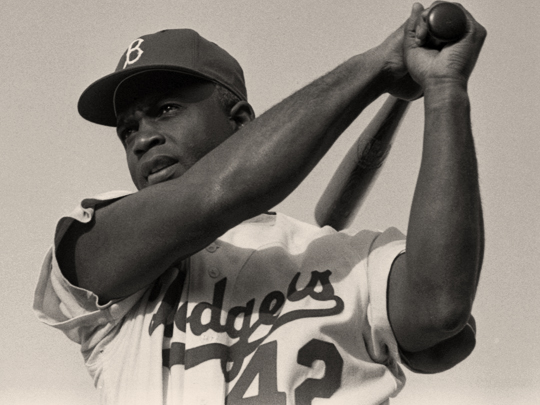By Bob Sandberg / Wikimedia Commons / CC-BY-SA-3.0 / GFDL
1 – Jackie Robinson Becomes First African-American to Play in US Major League Baseball
Jackie Robinson was an American Major League Baseball second baseman who became the first African American to play in the major leagues in the modern era.
Robinson broke the baseball color line when the Brooklyn Dodgers started him at first base on April 15, 1947.
The Dodgers, by playing Robinson, heralded the end of racial segregation that had relegated black players to the Negro leagues since the 1880s.
He was the recipient of the inaugural MLB Rookie of the Year Award in 1947, an All-Star for six consecutive seasons from 1949 through 1954, and won the National League Most Valuable Player Award in 1949.
Robinson was inducted into the Baseball Hall of Fame in 1962. In 1997, MLB retired his uniform number, 42, across all major league teams, the first pro athlete in any sport to be so honored.
MLB also adopted a new annual tradition, “Jackie Robinson Day”, for the first time on April 15, 2004, on which every player on every team wears No. 42.
Robinson’s character, his use of nonviolence, and his unquestionable talent challenged the traditional basis of segregation which then marked many other aspects of American life.
Robinson also was the first black television analyst in MLB, and the first black vice president of a major American corporation, Chock full o’Nuts.
In recognition of his achievements on and off the field, Robinson was posthumously awarded the Congressional Gold Medal and Presidential Medal of Freedom.
2 – The Black Dahlia Murder
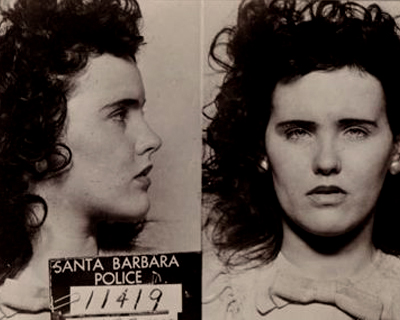
The Black Dahlia was a nickname given to Elizabeth Short, an American woman, aged 22, who was the victim of a much-publicized murder in 1947.
Short acquired the moniker posthumously from newspapers in the habit of nicknaming crimes they found particularly lurid.
The “Black Dahlia” nickname may have been derived from a film noir murder mystery, The Blue Dahlia, released in April 1946.
Short was found mutilated, her body sliced in half at the waist, on January 15, 1947, in Leimert Park, Los Angeles, California.
Short’s unsolved murder has been the source of widespread speculation, leading to many suspects, along with several books, television and film adaptations of the story.
Short’s murder is one of the oldest unsolved murder cases in Los Angeles history.
3 – Arabs Reject British Proposal to Split Palestine with Jewish People
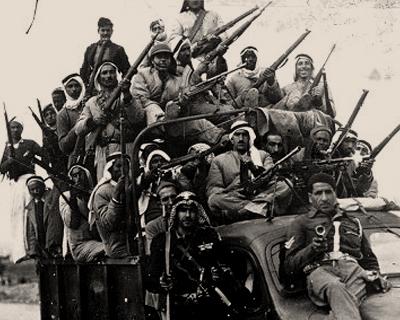
The United Nations Partition Plan for Palestine was a proposal by the United Nations, which recommended a partition of Mandatory Palestine at the end of the British Mandate.
On 29 November 1947, the U.N. General Assembly adopted the Plan as Resolution 181(II).
Immediately after the adoption of the Resolution by the General Assembly, a civil war broke out and the plan was not implemented.
The resolution recommended the creation of independent Arab and Jewish States and a Special International Regime for the city of Jerusalem.
The Partition Plan provided for the termination of the Mandate, the progressive withdrawal of British armed forces and the delineation of boundaries between the two States and Jerusalem.
The new states would come into existence no later than 1 October 1948. The Plan sought to address the conflicting objectives and claims of two competing movements, Palestinian nationalism, and Jewish nationalism, or Zionism.
The Plan also called for Economic Union between the proposed states, and for the protection of religious and minority rights.
The Plan was accepted by the Jewish Agency for Palestine, despite its perceived limitations.
Arab leaders and governments rejected it and indicated an unwillingness to accept any form of territorial division.
They argued that it violated the principles of national self-determination in the UN Charter which granted people the right to decide their own destiny.
4 – The Partition of India

The Partition of the British Indian Empire led to the creation of the sovereign states of the Dominion of Pakistan (later split into Pakistan and Bangladesh) and the Union of India (later the Republic of India) on 15 August 1947.
In the riots which preceded the partition in the Punjab Province, it is believed that between 200,000 and 2,000,000 people were killed in the retributive genocide between the religions.
UNHCR estimates 14 million Hindus, Sikhs and Muslims were displaced during the partition, which was the largest mass migration in human history.
Burma was granted independence on 4 January 1948 and Ceylon on 4 February 1948.
Bhutan, Nepal and the Maldives, the remaining present-day countries of South Asia, were unaffected by the partition.
5 – The Dead Sea Scrolls are Discovered at Qumran
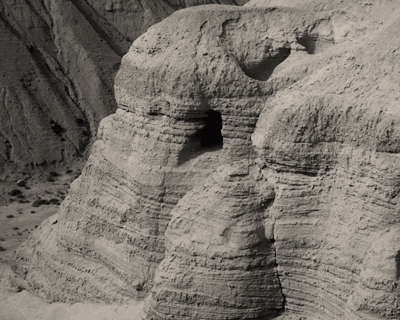
The Dead Sea Scrolls are a collection of 981 different texts discovered between 1946 and 1956.
The Scrolls were found in eleven caves in the immediate vicinity of the Hellenistic period Jewish settlement at Khirbet Qumran in the eastern Judaean Desert, the modern West Bank.
The caves are located about two kilometers inland from the northwest shore of the Dead Sea.
The consensus is that the Qumran Caves Scrolls date from the last three centuries BCE and the first century CE.
Bronze coins found at the same sites date from 135–104 BC to the First Jewish–Roman War, 66–73 AD, supporting the radiocarbon dating of the scrolls.
The initial discovery, by Bedouin shepherd Muhammed edh-Dhib, his cousin Jum’a Muhammed, and Khalil Musa took place between November 1946 and February 1947.
The shepherds discovered seven scrolls housed in jars in a cave near what is now known as the Qumran site.
6 – US Secretary of State George Marshall Outlines the ‘Marshall Plan’
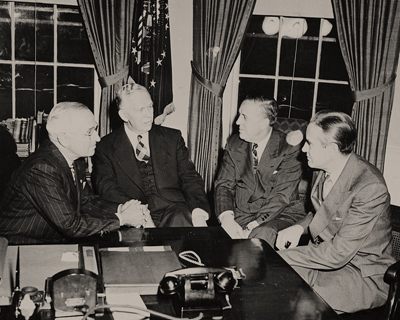
The Marshall Plan was an American initiative to aid Western Europe, in which the United States gave over $13 billion in economic support to help rebuild Western European economies after the end of World War II.
The plan was in operation for four years beginning April 8, 1948.
The goals of the United States were to rebuild war-devastated regions, remove trade barriers, modernize industry, make Europe prosperous again, and prevent the spread of communism.
The reconstruction plan, developed at a meeting of the participating European states, was drafted on June 5, 1947.
It offered the same aid to the Soviet Union, but they refused to accept it, as doing so would allow a degree of US control over the Communist economies.
The Soviet Union also prevented its satellite states (East Germany, Poland, etc.) from accepting the offer.
President Harry Truman signed the Marshall Plan on April 3, 1948, granting $5 billion in aid to 16 European nations.


